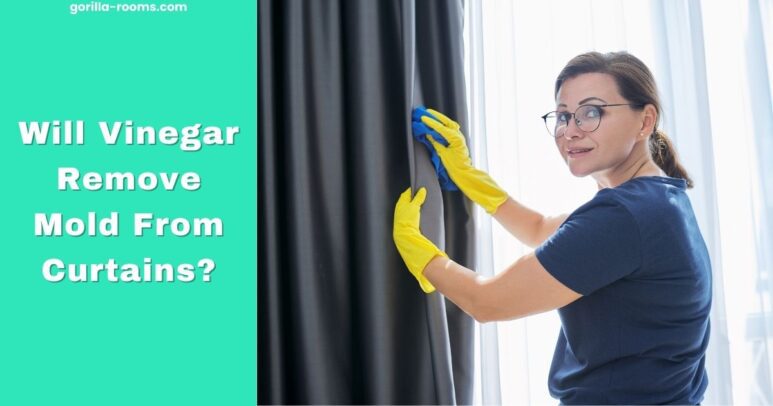It’s every homeowner’s nightmare: you open your curtains, and there it is, a big old patch of mold. It is unsightly and can also be dangerous, causing respiratory problems and even allergic reactions.
So, what’s the best way to get rid of mold from curtains? Can you use vinegar to remove mold from the curtains.
Yes vinegar can remove mold from curtains. However, it’s important to note that vinegar is not a registered disinfectant with the EPA and is not considered a “one-stop shop” regarding mold removal. In other words, you’ll still need to take other steps to ensure that all the mold is gone.
In this article, I will discuss whether you should use vinegar to remove mold from different types of curtains.
Will Vinegar Remove Mold From Cotton Curtains?

Yes, vinegar can remove mold from cotton curtains safely without harming the fabric.
This is due to the fact that vinegar is a weak acid, and therefore will not damage the delicate fibers of cotton fabric. That said, vinegar is also a natural disinfectant, which makes it ideal for cleaning mold.
However, it is important to note that vinegar should only be used as a spot treatment for moldy areas. It should not be used as a full-blown cleaning solution, as this could result in the cotton fabric becoming discolored.
If you do choose to use vinegar to clean your curtains, make sure to dilute it with water first, and always test it on a small area of the fabric before proceeding.
Related Post: BEST CURTAINS FOR DARK ROOMS
Will Vinegar Remove Mold From Silk Curtains?

Silk is one of the strongest natural fibers, but it is also very delicate. When used for curtains, silk helps to create a luxurious and elegant look. However, silk is also susceptible to mold growth.
Fortunately, vinegar can be used to safely remove mold from silk curtains.
Vinegar is a weak acid that can kill mold spores. It is also effective at breaking down mold filaments and removing mold stains. When cleaning silk curtains with vinegar, it is important to dilute the vinegar with water to avoid damaging the fabric.
You should also test the Vinegar on a small area before applying it to the entire curtain. In most cases, vinegar will not discolor silk fabric. However, it is always best to test it on the side of caution when cleaning delicate fabrics.
Will Vinegar Remove Mold From Linen Curtains?

When used on linen, vinegar will also help to loosen and remove mold spores from the fabric. However, it’s important to note that vinegar can also discolor linen, so it’s best to test it on a small area of the fabric first.
Here’s how to clean mold effectively from linen curtains.
- To clean mold from linen curtains with vinegar, simply mix equal parts vinegar and water in a spray bottle and mist the affected areas.
- Let the solution sit for at least 10 minutes before wiping it away with a damp cloth.
- You may need to repeat this process several times to completely remove all the mold.
Will Vinegar Remove Mold From Velvet Curtains?

Yes, vinegar can remove mold from velvet curtains, but you need to be careful and use it correctly. Be sure to spot test first and always rinse the curtains thoroughly afterward.
Vinegar is a naturally acidic substance that can kill mold and mildew, making it a great choice for cleaning velvet curtains. However, before you start spraying vinegar all over your curtains, there are a few things you need to know.
First of all, it’s vital to understand that vinegar can damage velvet if it’s not used properly. Because vinegar is so acidic, it can eat away at the delicate fibers of velvet, causing them to break down and disintegrate.
So, if you’re going to use vinegar to clean your velvet curtains, you need to be very careful.
Apply the vinegar directly to the moldy areas using a soft cloth or brush, and be sure to rinse the curtains thoroughly afterward with clean water.
Another thing to keep in mind is that vinegar can sometimes cause colors to run or fade.
So, if your velvet curtains are colored, you may want to test the vinegar on a small hidden area first to see if it will affect the color. In most cases, however, the color should be safe.
Which Type Of Vinegar Should I Need To Use For Curtains?
There are many different types of vinegar, and each has its benefits.
White vinegar is the most popular type for cleaning because it is gentle and effective. It can be used on most types of fabric, including curtains. White vinegar is also inexpensive and easy to find.
Apple cider vinegar is another popular type of vinegar for cleaning. It is made from apples, so it is natural and gentle. Apple cider vinegar also has antibacterial properties, making it a good choice for curtains prone to mold or mildew.
Distilled vinegar is another option for cleaning curtains. It is made by distilling alcohol, so it is powerful. Distilled vinegar should only be used on adamant stains or on filthy curtains.
When using any type of vinegar to clean curtains, test a small area first to ensure the fabric can handle the cleaning solution.
How Long Does It Take for Vinegar to Kill Mold?
The answer depends on the amount of mold present. For light mold growth, simply letting the vinegar sit on the surface for 60 minutes should be sufficient. However, for heavier growth, you may need to let the vinegar sit for up to 24 hours.
In either case, protect your hands and eyes with gloves and safety goggles while you work. Once the mold has been killed, simply wipe or scrub it away.
How To Remove Mould From Curtains Naturally?
Many people reach for harsh chemicals when they see mold, but a few simple Household hacks can remove it just as effectively.
One natural way to remove mold is with baking soda. Baking soda is a mild abrasive that can safely scrub away mold without damaging the fabric.
To use this method, mix one-quarter of a tablespoon of baking soda into a spray bottle of water. Shake the mixture until the baking soda has dissolved, then spray the moldy area of your curtain. Scrub the area with a brush to remove the mold, then rinse the surface with water to remove any residue.
If you don’t have baking soda on hand, vinegar is another effective option for removing mold. Vinegar is a natural disinfectant that kills mold spores and prevents them from returning.
Mix equal parts vinegar and water in a spray bottle to use this method. Spray the mixture onto the moldy area of your curtain, then use a brush to scrub away the mold. Rinse the surface with water when you’re finished.
Vinegar vs Baking Soda: Which Is Best To Remove Mold From Curtains?
The two most popular options for removing mold are vinegar and baking soda. But which one is the best at getting the job done?
Vinegar
Vinegar is an excellent option for mold removal because it contains acetic acid. This acid is effective at killing around 82% of mold species.
Vinegar is also a natural disinfectant, so it can help to prevent mold from coming back. However, vinegar can be harsh on some surfaces, so it’s essential to test it on a small area first.
Baking Soda
Baking soda is another popular choice for mold removal. Baking soda absorbs moisture, which makes it difficult for mold to grow.
It’s also non-toxic and gentle on surfaces, making it an excellent option for areas sensitive to chemicals. However, baking soda isn’t as effective at killing mold as vinegar is. There might be better choices than this if you’re dealing with a severe mold problem.
Tips for Keeping Your Curtains Mould-Free
No one likes dealing with mold. It’s unsightly, can cause health problems, and is just plain gross. If you’re struggling to keep your curtains mold-free, there are a few things you can do.
- First, Make sure they’re made of a mold-resistant fabric. If they’re not, consider replacing them.
- Keep your windows clean and free of condensation.
- Open them regularly to allow fresh air to circulate.
- Remember to vacuum and dust your curtains regularly.
These simple tips can help keep your curtains looking and smelling fresh all year round.
Final Verdict
To sum it up, both vinegar and baking soda can effectively remove mold fro the curtains. But vinegar is more effective at killing mold spores, while baking soda is better at preventing mold from growing in the first place. Depending on your situation, either one is the best choice for you.
FAQs
Is vinegar effective at killing mold?
Yes, vinegar is very effective at killing mold. It contains acetic acid, killing up to 82% of all known species of mold.
Can I use bleach to remove mold from my curtains?
No, bleach should not be used on your curtains. It is highly acidic and can damage the fabric and cause respiratory irritation if misused.
How often should I clean my curtains to prevent mold?
You should vacuum and dust your curtains regularly to help keep them free from mold. Also, try to open your windows regularly to allow fresh air and sunlight in. This will help discourage mold from growing in the first place.
What can I do if my curtains are already infested with mold?
If your curtains are already infested with mold, you should start by cleaning them with vinegar and water. You can also use baking soda to help absorb excess moisture and prevent mold from growing back. For more severe cases of mold, you may need to replace the curtains altogether.
Related Post:

